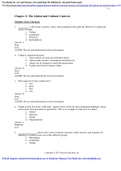Samenvatting
1ZM130-1ZM140 Design Science Methodology - Quiz 2 Summary articles and book chapters
- Vak
- Instelling
Summary of all articles and book chapters required for Quiz 2 of the master course 1ZM130/1ZM140. Articles: (Denyer & Tranfield, 2009), (Denyer et al, 2008) Book chapters: 5.1
[Meer zien]












